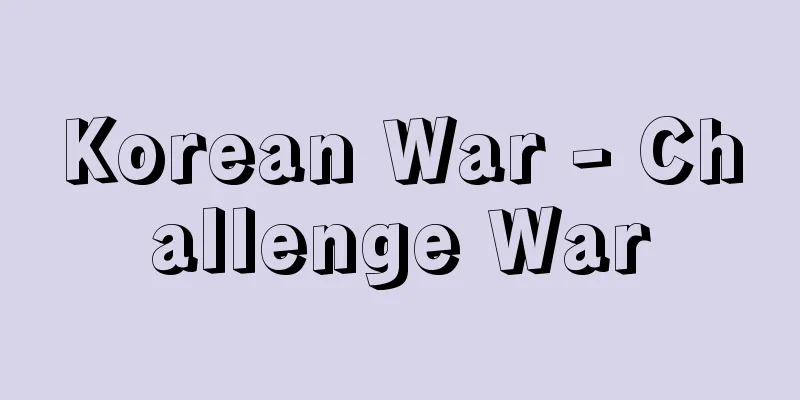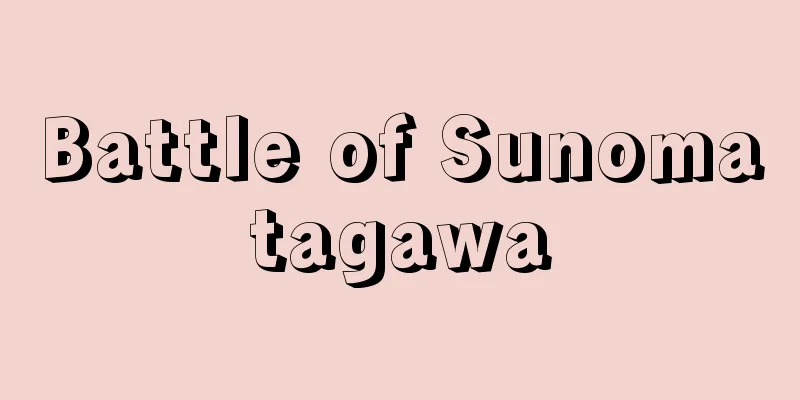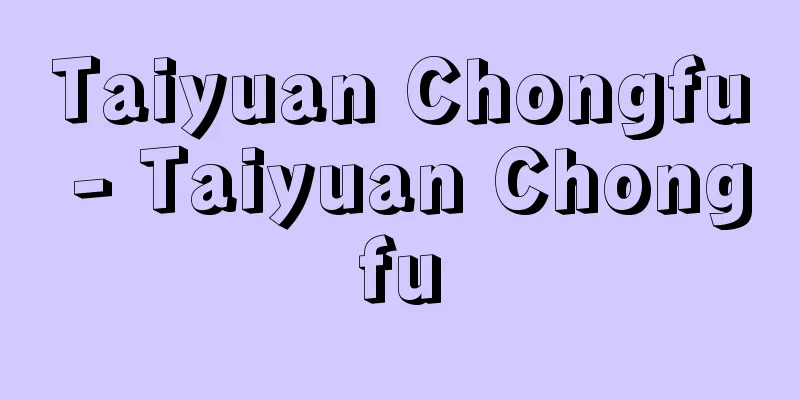Korean War - Challenge War

|
A large-scale international conflict that took place over three years, from June 25, 1950 to July 27, 1953, with almost the entire Korean Peninsula turned into a battlefield. It is also called the Korean War or the Korean War. In South Korea (Republic of Korea), it is called the "June 25th War," and in North Korea, it is called the "Fatherland Liberation War." [Keizo Kawagoe] scaleOn one side of the conflict were North Korea and the People's Republic of China, which sent the People's Volunteer Army to support North Korea, and on the other side were South Korea and 16 Western countries, mainly the United States, which organized the United Nations Army to support South Korea. The Soviet Union provided arms, ammunition, and other support materials to North Korea and China, as well as military advisors, pilots, and medical units. The number of troops deployed to the battlefield was estimated to be about 3 million for North Korea and China (about 1.5 million each for North Korea and China), and about 2.6 to 2.7 million for the UN and South Korean forces (about 2 million of which were South Korean troops). More than 90% of the UN forces were US troops. The 16 Western countries that sent combat troops to the UN forces were as follows: the United States, the United Kingdom, France, Belgium, the Netherlands, Luxembourg, Greece, Turkey, Australia, New Zealand, Canada, Colombia, Thailand, the Philippines, Ethiopia, and the Union of South Africa. In addition, five countries, India, Italy, Denmark, Norway, and Sweden, provided medical units or medical facilities to the UN forces. [Keizo Kawagoe] Cause and natureThe Cold War between the US and the Soviet Union, which quickly emerged immediately after the Second World War, led to Korea being divided into North and South Korea and hostility towards each other. It is clear that this was an indirect cause, but there is still much debate about the direct cause of the war and its nature. In South Korea, the US, and other Western countries, it is generally believed that it began with an armed invasion of South Korea from the North. North Korea, on the other hand, claims that the US, which wanted to overthrow the country, instigated the South Korean government and sparked the war. In recent Japanese research, the theory that the North attacked first has become more prevalent. In other words, the North Korean view is that North Korea, which considered South Korea a de facto colony of the US, took the initiative of South Korean President Syngman Rhee, who called for the armed unification of North and South Korea, and launched military action to "liberate the southern half." To that extent, the war began as a kind of civil war on the Korean Peninsula, but it developed into a large-scale international conflict when the US intervened militarily. It is certain that the American military intervention was aimed at preventing the expansion of socialism and so-called national liberation movements in Asia. [Keizo Kawagoe] ProgressIn the early morning of June 25, 1950, clashes broke out in several places between the Korean People's Army (North) and the South Korean Army (South), facing each other across the 38th parallel, and the Korean People's Army pursued the retreating South Korean Army southward. US President Truman immediately decided to intervene militarily, ordering the US Navy and Air Force in Japan, then the Army, while also calling for the United Nations to intervene. The UN Security Council, convened without a Soviet representative, adopted a resolution condemning North Korea as a "breaker of peace" (June 25, New York time), recommended that UN member countries provide military support to South Korea (June 27), and decided to establish the Supreme Commander-in-Chief of the United Nations Command, with General Douglas MacArthur of the US Forces in Japan as its commander (July 7). This UN force was different from the regular UN forces stipulated in Chapter 7 of the UN Charter. The South Korean forces were handed over command to General MacArthur and came under his command. On June 27, President Truman also dispatched the U.S. 7th Fleet to the Taiwan Strait to prevent communist forces from attacking Taiwan, and at the same time decided to increase military aid to the Philippine government, which was struggling to suppress left-wing guerrilla forces, and to the French forces in South Vietnam, which were fighting the First Indochina War. The Korean War had four main stages. (1) In the first 70 days after the outbreak of the war, the Korean People's Army enjoyed overwhelming superiority. Seoul, the capital of South Korea, fell on June 28, 1950, and by early September the UN and ROK forces had been confined to a small area at the southern tip of the peninsula, including Daegu and Busan. (2) On September 15 and 16, the UN forces carried out a surprise landing operation in Incheon and launched a counterattack in the Daegu area. The UN and ROK forces crossed the 38th Parallel in early October and occupied Pyongyang on the 19th of the same month, with some of their forces reaching the banks of the Yalu River. (3) On October 25, a large force of the Chinese People's Volunteer Army crossed the Yalu River to join the war and counterattacked together with the Korean People's Army. They recaptured Pyongyang on December 4, and reoccupied Seoul on January 4, 1951. On February 1, the 5th United Nations General Assembly passed a resolution condemning China as an "aggressor." UN and South Korean forces recaptured Seoul on March 14, but fierce fighting continued near the 38th parallel. General MacArthur unilaterally insisted on bombing the Chinese mainland, and was dismissed by President Truman on April 11. (4) After June, the front line was at a stalemate, and both sides built strong positions and engaged in fierce wars of attrition. The UN and ROK forces attempted to seize the eastern and central mountain areas of the front line in the "Summer and Autumn Offensives" from August to November, but failed due to stubborn resistance, including the Korean People's Army's fortress "Hill 1211" which withstood a fierce attack for over two months. The major offensive by the UN and ROK forces in October-November the following year, 1952, ended with a similar result. The battle for the triangular area connecting Cheorwon, Pyonggang, and Kimhwa, a key point in the central region north of the 38th parallel, was particularly fierce, and was called the fierce battle of the "Iron Triangle." During this time, various parts of North Korea were subjected to artillery and bombing, as well as bacteriological and gas shells. The Eisenhower administration, which took office in January 1953, considered using the atomic bomb to turn the tide of the war, but ultimately gave up on the idea. [Keizo Kawagoe] TruceOn June 23, 1951, Yakov Malik, the Soviet representative to the United Nations, proposed a ceasefire over the radio, which prompted ceasefire talks between the warring sides to begin in Kaesong on July 10 of the same year. Negotiations continued intermittently for the next two years as fierce fighting continued, and finally an armistice agreement was signed at Panmunjom on July 27, 1953. The signatories to the agreement were Supreme Commander of the Korean People's Army Kim Il-sung and Commander-in-Chief of the Chinese People's Volunteer Army Peng Dehuai on one side, and Commander-in-Chief of the United Nations Command Mark Clark on the other. South Korea was dissatisfied with the armistice and refused to sign. Although a ceasefire was reached, a peace treaty as a final settlement to the war has not been concluded to this day. The damage on both sides in this war was enormous, with the deaths of about 420,000 South Korean soldiers, about 50,000 US soldiers, about 3,000 other UN troops, and over 1.06 million South Korean civilians on the UN/ROK side, while the deaths and injuries of military personnel alone on the North Korean/Chinese side were estimated at more than 2 million. Japan was not a participant in the war, but it was still under occupation at the time the war began, so its land and industry were used to carry out the UN's operations, and there were also casualties among sailors mobilized for maritime transport and minesweeping. In addition, the establishment of the National Police Reserve (the precursor to the Self-Defense Forces), the strengthening of restrictions on left-wing movements, and the revitalization of the economy through "war demand" marked a major turning point in postwar Japanese politics and economy. [Keizo Kawagoe] "The Secret History of the Korean War" by I.F. Stone, translated by Uchiyama Satoshi (1966, Aoki Shoten)" ▽ "The History of the Korean War" by D.W. Conde, supervised translation by Rikui Saburo (1967, Taihei Shuppansha)" ▽ "The Outbreak of the Korean War" by Nobuo Seizaburo (1971, Fukumura Shuppan)" Source: Shogakukan Encyclopedia Nipponica About Encyclopedia Nipponica Information | Legend |
|
1950年6月25日から53年7月27日まで、3年余にわたり朝鮮半島のほとんど全域を戦場化して戦われた大規模な国際紛争。朝鮮動乱あるいは韓国動乱ともいう。韓国(大韓民国)ではこれを「六・二五動乱」とよび、北朝鮮では「祖国解放戦争」と名づけている。 [川越敬三] 規模交戦当事国の一方は北朝鮮およびそれを支援して人民志願軍(義勇軍)を派遣した中華人民共和国、他方は韓国およびそれを支援して国連軍を編成したアメリカ中心の西側16か国。ソ連は朝・中側に武器弾薬その他の支援物資を提供したほか、軍事顧問、パイロット、医療部隊などを派遣した。戦場に投入された兵力は朝・中側が約300万人(朝・中各約150万人)、国連・韓国軍側が約260万~270万人(うち韓国軍約200万人)と推定された。国連軍兵力の90%以上は米軍である。国連軍に実戦部隊を派遣した西側16か国は以下のとおり。アメリカ、イギリス、フランス、ベルギー、オランダ、ルクセンブルク、ギリシア、トルコ、オーストラリア、ニュージーランド、カナダ、コロンビア、タイ、フィリピン、エチオピアおよび南アフリカ連邦。このほかインド、イタリア、デンマーク、ノルウェーおよびスウェーデンの五か国が医療部隊ないし医療施設を国連軍に提供した。 [川越敬三] 原因と性格第二次世界大戦直後から急速に表面化した米ソの「冷戦」のもとで、朝鮮は南北に分裂し反目しあうことになった。それが遠因となったことは明らかだが、この戦争の直接の原因と戦争の性格については、いまなお多くの議論がある。韓国、アメリカなど西側諸国では一般に、韓国に対する北からの武力侵攻が発端になったとする見解がとられている。北朝鮮ではそれと反対に、同国の打倒をねらったアメリカが韓国政府を唆して引き起こしたと主張している。近年の日本の研究では、北側からの攻撃先行説が有力視されるようになった。すなわち、韓国をアメリカの事実上の植民地とみなした北朝鮮が、南北朝鮮の武力統一を呼号する李承晩(りしょうばん/イスンマン)韓国大統領の先手をとって「南半部解放」の軍事行動を起こし、その限りでは戦争は朝鮮半島における一種の内戦として始まったが、アメリカがこれに軍事介入したことから、大規模な国際紛争に発展したとする見方である。アメリカの軍事介入が、アジアにおける社会主義といわゆる民族解放運動の勢力拡大阻止を目的にして行われたことは確かである。 [川越敬三] 経過1950年6月25日早朝、北緯38度線を挟んで対峙(たいじ)中の朝鮮人民軍(北)と韓国軍(南)の間に数か所で衝突が起こり、朝鮮人民軍は敗走する韓国軍を追って南下した。トルーマン米大統領はただちに軍事介入を決定して在日米海・空軍、ついで陸軍に出動を命令する一方、国際連合にも介入を働きかけた。ソ連代表不在のまま招集された国連安保理事会は北朝鮮を「平和の破壊者」と非難する決議を採択し(ニューヨーク時間6月25日)、国連加盟諸国に韓国への軍事支援を勧告し(6月27日)、日本駐留米軍のダグラス・マッカーサー元帥を司令官とする国連軍総司令部の設置を決定した(7月7日)。この国連軍は国連憲章第7章に規定された正規の国連軍とは異質のものである。韓国軍は統帥権をマッカーサー総司令官に委譲してその指揮下に入った。トルーマン大統領はまた6月27日、共産勢力の台湾攻撃阻止を理由に米第7艦隊を台湾海峡へ出動させ、同時に左翼ゲリラ鎮圧に手を焼くフィリピン政府と、第一次インドシナ戦争遂行中の南ベトナム駐留フランス軍に対する軍事援助増強を決定した。 朝鮮戦争の戦局にはほぼ四つの段階があった。 (1)戦争勃発(ぼっぱつ)直後の70日間は朝鮮人民軍の圧倒的優勢のうちに進展した。1950年6月28日には韓国の首都ソウルが陥落、国連・韓国軍は9月初めには大邱(たいきゅう/テグ)、釜山(ふざん/プサン)を含む半島南端の狭い一角に追い詰められた。 (2)国連軍は9月15、16両日仁川(じんせん/インチョン)で大部隊の奇襲上陸作戦を行い、大邱地区でも反攻に転じた。国連・韓国軍は10月初めに38度線を突破し、同月19日平壌を占領、一部の部隊は鴨緑江(おうりょくこう)岸まで到達した。 (3)10月25日、中国人民志願軍の大部隊が鴨緑江を越えて参戦し、朝鮮人民軍とともに反撃した。12月4日には平壌を奪回し、翌51年1月4日、ソウルを再占領した。第5回国連総会は2月1日、中国を「侵略者」と非難する決議を採択した。国連・韓国軍は3月14日ソウルを再奪回したが、38度線付近では激闘が続いた。マッカーサー総司令官は中国本土爆撃を独断で主張、4月11日トルーマン大統領によって罷免された。 (4)6月以降戦線は膠着(こうちゃく)し、双方は互いに強固な陣地を構築して激しい消耗戦を繰り返した。国連・韓国軍は8月から11月にかけての「夏季・秋季攻勢」で戦線東・中部山岳地帯の制圧を試みたが、朝鮮人民軍の要塞(ようさい)「1211高地」が2か月余にわたる猛攻に耐えぬくなど頑強な抵抗にあって成功しなかった。翌52年10~11月の国連・韓国軍の大攻勢も同じような結果に終わった。中部の要衝である38度線北方の鉄原(てつげん/チョルウォン)―平康(へいこう/ピョンカン)―金化(きんか/クムホワ)を結ぶ三角地帯の攻防戦はとくに激烈で、「鉄の三角地帯」の激闘とよばれた。この間、北朝鮮各地は砲爆撃にさらされ、細菌弾、ガス弾にもみまわれた。1953年1月に発足したアイゼンハワー米政権は戦局打開のため原爆使用を検討したが、結局使用に踏み切ることは断念した。 [川越敬三] 休戦1951年6月23日、ソ連の国連代表ヤコブ・マリクがラジオ放送で休戦を提案し、これを契機に同年7月10日から開城(かいじょう/ケーソン)で交戦双方による休戦会談が始まった。その後2年間、激しい戦闘が続くかたわらで交渉が断続的に行われ、1953年7月27日、ようやく板門店(はんもんてん/パンムンチョム)での休戦協定調印にこぎ着けた。協定調印者は、一方が朝鮮人民軍最高司令官金日成(きんにっせい/キムイルソン)と中国人民志願軍司令員彭徳懐(ほうとくかい/ポントーホワイ)、他方が国連軍総司令官マーク・クラーク。韓国は休戦を不満として調印を拒否した。休戦にはなったものの、戦争の最終処理としての平和条約は締結されないまま今日に至っている。 この戦争での交戦双方の被害は甚大で、国連・韓国軍側の戦死者は韓国軍約42万人、米軍約5万人、その他の国連軍約3000人、ほかに韓国民間人106万余人といわれ、朝・中側は軍要員の死傷者だけで200万人以上と推定された。日本は参戦国ではなかったが、開戦当時まだ占領下にあったため、国土と産業をあげて国連軍の作戦遂行のために使われ、海上輸送や掃海業務に動員された船員のなかから死傷者も出た。また、この戦争に関連して実現した警察予備隊(自衛隊の前身)の発足、左翼運動規制の強化、「戦争特需」による経済活性化などは、戦後日本の政治、経済にとって一つの重大な転機となった。 [川越敬三] 『I・F・ストーン著、内山敏訳『秘史・朝鮮戦争』(1966・青木書店)』▽『D・W・コンデ著、陸井三郎監訳『朝鮮戦争の歴史』(1967・太平出版社)』▽『信夫清三郎著『朝鮮戦争の勃発』(1971・福村出版)』 出典 小学館 日本大百科全書(ニッポニカ)日本大百科全書(ニッポニカ)について 情報 | 凡例 |
<<: Government General of Korea - Chosen Sou Kokufu
Recommend
Extremely Large - Kyokudai
[noun/adjective] 1. Extremely large. Also, the sta...
Hunkar Iskelesi (English spelling)
…A treaty of mutual assistance concluded on July ...
Historical School - rekishigaku is (English spelling) historische Schule German
The orthodox school of economics in Germany at th...
Nine colors group - Kuishikishu
…The Nakamichi road runs through the area, connec...
Records of the change of the province of Ueno
This is a draft of an official document for the ch...
Taiko Hirabayashi - Taiko Hirabayashi
Novelist. Born in Nagano Prefecture on October 3,...
Procyon lotor (English spelling)
...A mammal of the carnivorous family Procyonidae...
International Table Tennis Federation
…The first association was established in the UK ...
First rehearsal - Ichijirihasaru
…In this model, it was thought that the longer in...
Anulomakon - Anulomakon
...The name of the four major classes in Indian s...
Well material
A fee for repairing or using irrigation water such...
du Paquier, CI (English spelling) duPaquierCI
…A famous Austrian kiln that was the second in Eu...
sinusoidal cell
The central vein is a small blood vessel that con...
Direct writing - Jikisho
〘noun〙① (━suru) something that a person writes dir...
Catalan - Catalan
It is a language that belongs to the Italic branch...









